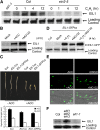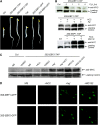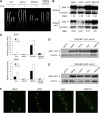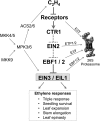Ethylene-induced stabilization of ETHYLENE INSENSITIVE3 and EIN3-LIKE1 is mediated by proteasomal degradation of EIN3 binding F-box 1 and 2 that requires EIN2 in Arabidopsis
- PMID: 20647342
- PMCID: PMC2929093
- DOI: 10.1105/tpc.110.076588
Ethylene-induced stabilization of ETHYLENE INSENSITIVE3 and EIN3-LIKE1 is mediated by proteasomal degradation of EIN3 binding F-box 1 and 2 that requires EIN2 in Arabidopsis
Abstract
Plant responses to ethylene are mediated by regulation of EBF1/2-dependent degradation of the ETHYLENE INSENSITIVE3 (EIN3) transcription factor. Here, we report that the level of EIL1 protein is upregulated by ethylene through an EBF1/2-dependent pathway. Genetic analysis revealed that EIL1 and EIN3 cooperatively but differentially regulate a wide array of ethylene responses, with EIL1 mainly inhibiting leaf expansion and stem elongation in adult plants and EIN3 largely regulating a multitude of ethylene responses in seedlings. When EBF1 and EBF2 are disrupted, EIL1 and EIN3 constitutively accumulate in the nucleus and remain unresponsive to exogenous ethylene application. Further study revealed that the levels of EBF1 and EBF2 proteins are downregulated by ethylene and upregulated by silver ion and MG132, suggesting that ethylene stabilizes EIN3/EIL1 by promoting EBF1 and EBF2 proteasomal degradation. Also, we found that EIN2 is indispensable for mediating ethylene-induced EIN3/EIL1 accumulation and EBF1/2 degradation, whereas MKK9 is not required for ethylene signal transduction, contrary to a previous report. Together, our studies demonstrate that ethylene similarly regulates EIN3 and EIL1, the two master transcription factors coordinating myriad ethylene responses, and clarify that EIN2 but not MKK9 is required for ethylene-induced EIN3/EIL1 stabilization. Our results also reveal that EBF1 and EBF2 act as essential ethylene signal transducers that by themselves are subject to proteasomal degradation.
Figures










Similar articles
-
The Arabidopsis EIN3 binding F-Box proteins EBF1 and EBF2 have distinct but overlapping roles in ethylene signaling.Plant Cell. 2007 Feb;19(2):509-23. doi: 10.1105/tpc.106.048140. Epub 2007 Feb 16. Plant Cell. 2007. PMID: 17307926 Free PMC article.
-
Salt-induced stabilization of EIN3/EIL1 confers salinity tolerance by deterring ROS accumulation in Arabidopsis.PLoS Genet. 2014 Oct 16;10(10):e1004664. doi: 10.1371/journal.pgen.1004664. eCollection 2014 Oct. PLoS Genet. 2014. PMID: 25330213 Free PMC article.
-
Interaction between the bHLH transcription factor FIT and ETHYLENE INSENSITIVE3/ETHYLENE INSENSITIVE3-LIKE1 reveals molecular linkage between the regulation of iron acquisition and ethylene signaling in Arabidopsis.Plant Cell. 2011 May;23(5):1815-29. doi: 10.1105/tpc.111.084715. Epub 2011 May 17. Plant Cell. 2011. PMID: 21586684 Free PMC article.
-
Paradigms and paradox in the ethylene signaling pathway and interaction network.Mol Plant. 2011 Jul;4(4):626-34. doi: 10.1093/mp/ssr042. Epub 2011 Jun 20. Mol Plant. 2011. PMID: 21690206 Review.
-
Seedlings Transduce the Depth and Mechanical Pressure of Covering Soil Using COP1 and Ethylene to Regulate EBF1/EBF2 for Soil Emergence.Curr Biol. 2016 Jan 25;26(2):139-149. doi: 10.1016/j.cub.2015.11.053. Epub 2015 Dec 31. Curr Biol. 2016. PMID: 26748855 Free PMC article. Review.
Cited by
-
Ubiquitin-mediated control of plant hormone signaling.Plant Physiol. 2012 Sep;160(1):47-55. doi: 10.1104/pp.112.200527. Epub 2012 Jun 21. Plant Physiol. 2012. PMID: 22723083 Free PMC article. No abstract available.
-
The Effect of Ethephon on Ethylene and Chlorophyll in Zoysia japonica Leaves.Int J Mol Sci. 2024 Jan 29;25(3):1663. doi: 10.3390/ijms25031663. Int J Mol Sci. 2024. PMID: 38338942 Free PMC article.
-
Foes or Friends: ABA and Ethylene Interaction under Abiotic Stress.Plants (Basel). 2021 Feb 27;10(3):448. doi: 10.3390/plants10030448. Plants (Basel). 2021. PMID: 33673518 Free PMC article.
-
Transcriptome profiling of developmental leaf senescence in sorghum (Sorghum bicolor).Plant Mol Biol. 2016 Nov;92(4-5):555-580. doi: 10.1007/s11103-016-0532-1. Epub 2016 Sep 1. Plant Mol Biol. 2016. PMID: 27586543
-
Rice EIL1 interacts with OsIAAs to regulate auxin biosynthesis mediated by the tryptophan aminotransferase MHZ10/OsTAR2 during root ethylene responses.Plant Cell. 2022 Oct 27;34(11):4366-4387. doi: 10.1093/plcell/koac250. Plant Cell. 2022. PMID: 35972379 Free PMC article.
References
-
- Abeles F.B., Morgan P.W., Saltveit J.M.E. (1992). Ethylene in Plant Biology. 2nd ed (San Diego, CA: Academic Press; ).
-
- Alonso J.M., Hirayama T., Roman G., Nourizadeh S., Ecker J.R. (1999). EIN2, a bifunctional transducer of ethylene and stress responses in Arabidopsis. Science 284: 2148–2152 - PubMed
-
- Alonso J.M., et al. (2003b). Genome-wide insertional mutagenesis of Arabidopsis thaliana. Science 301: 653–657 - PubMed
-
- Bechtold N., Pelletier G. (1998). In planta Agrobacterium-mediated transformation of adult Arabidopsis thaliana plants by vacuum infiltration. Methods Mol. Biol. 82: 259–266 - PubMed
Publication types
MeSH terms
Substances
LinkOut - more resources
Full Text Sources
Molecular Biology Databases

